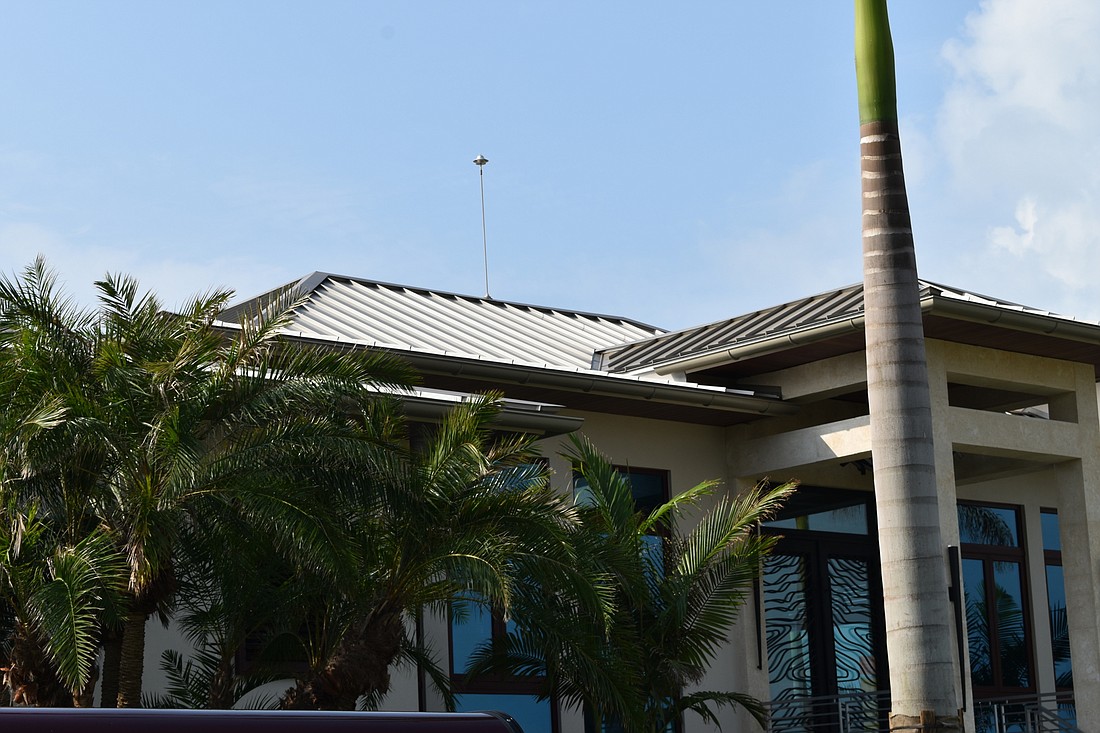- December 13, 2025
-
-
Loading

Loading

The Longboat Key Town Commission will move forward with allowing rooftop lightning rods on homes to be exempt from the town’s existing height regulations so long as they fulfill certain requirements.
Commissioners voted 7-0 on June 30 to ask staff to rewrite the measure to allow for a 1-foot exception to lightning rods higher than a home’s maximum height of 30 feet. The rewritten ordinance will also allow larger properties seek consideration of a special exception for lightning rods up to 6 feet.
Specifically, commissioners considered an application from Windemuller Technical Services Vice President John Barber to allow “lightning protection systems” to be included as an exception to height regulations.
“Currently, [there are] over 150 installations that are installed on Longboat Key,” Barber said. “I wish to continue with that not as a salesperson, but as a steward of the industry to allow homeowners the right to protect their property. This isn’t just a life safety as personnel, it is about structural protection.”
Barber’s application is on behalf of landowner Boris Miksick’s home at 640 Halyard Lane in Country Club Shores IV North, which stands at 29 feet, 9 inches before the addition of the rods.
“Height limitations again, restricts or forbids this property owner from protecting his home,” Barber said. “This is not the forum to debate the efficacy of any lightning protection technology versus another. This forum is not the place to determine the performance of one system over the other.”
The proposal seeks to amend the town’s zoning code, which does not list lightning rods as allowable items that exceed a home’s maximum height of 30 feet.
“One of the things that may be considered is to ask legal staff, is what is the liability the town has by not allowing this exception?” Barber said. “As it stands right now, you have hundreds if not thousands of existing homes that may be right at that 29-foot, 3-inch level. If you do not allow exceptions for lightning protection, you are — at that point — forbidding or restricting every home at that elevation from installing lightning protection systems.”
Barber asked commissioners and staff what legal remedies a homeowner would have against the town in the event of a lightning strike to their property.
“I get that concern,” Mayor Ken Schneier said. “I’m sure legal counsel will jump in and protect us as she [Town Attorney Maggie Mooney] deems necessary.”
Commissioner George Spoll pointed out that the code does allow exemptions for television or dish antennas.
“I just wanted everybody to have that perspective,” Spoll said. “This thing has been so selective and sloppily administered that we have an opportunity to clean this up in total.”
Planning, Zoning and Building Director Allen Parsons mentioned how the state’s building code does not require lightning protection systems to need building permits. It’s been the practice in the town of Longboat Key.
“We’re of the opinion, the building official is of the opinion as well, that it is appropriate for lighting protection systems to go through a permitting process,” Parsons said. “The Florida Building Code does allow for building officials to require building permits for things like this, so it’s not necessarily required, [but] we’re going to begin requiring this now going forward. We think that there’s real value in doing so.”
The town’s code also exempts enclosed elevator shafts and vestibules; eclipsed stairwells and landings; and closed mechanical equipment areas, parapet walls, worship center spires or towers, and any religious symbols or identifications emblems.
“My point is that simplicity and clear language makes it easy to understand where you’re going and how to administrate,” Spoll said. “We have been sloppy in that certain things have been allowed just by practice, others by code and what have you, so that when you try to be even-handed, it makes it very difficult.”
Anyone in the town with an existing lightning rod in place that does not fulfill the town’s pending regulations would be grandfathered in if the new rule is passed in September.
“If you have an existing lightning rod and it needs to be repaired or replaced and it’s already been in place, you would not have to take it down,” At-Large Commissioner BJ Bishop said.
Also, Longboat Key homeowners would be allowed to put more than one lightning rod on top of their homes for protection if they are abiding by the pending height regulations.
Schneier asked Dr. Vladimir Rakov — a professor at the University of Florida whose expertise is in electromagnetic and energy systems — if a homeowner has a “sufficient number” of 1-foot lightning rods, whether there was a need to increase the rods’ height for protection.
“I don’t think so,” Rakov said. “The principle of the standardized lightning protection is to intercept imminent lighting strikes, so 1-foot rods placed 20 feet apart will do the job, and this is known from practice.”
Several people spoke in opposition to the proposed lightning-rod height exception during the June 30 town commission meeting, including Country Club Shores Section IV Homeowner’s Association President Lynn Larson.
“Within the current code, when someone chooses to build a building at 30 feet and then comes in and claims they need a special exemption for additional 6 feet for this product, it sounds much like someone killing their parent and then claiming they’re an orphan,” Larson said.
Years ago, Larson collected more than 100 signatures from residents of her neighborhood to keep future single-family homes at the town’s 30-foot height limit with no add-ons or exceptions.
Town commissioners are expected to hold a second reading and final vote on the rewritten lightning-rod ordinance during their Sept. 14 meeting.